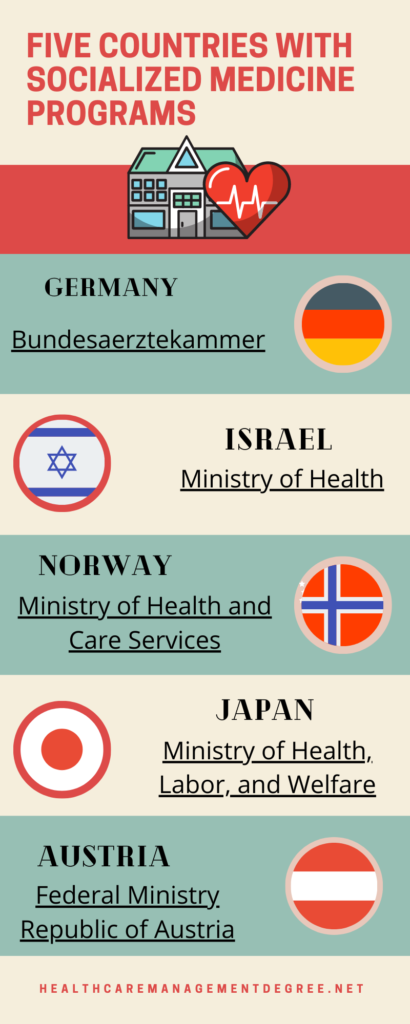
Is healthcare a fundamental human right?
More than thirty countries with socialized medicine feel it is necessary, while in the U.S., the debate remains hotly contested. Fears of the specter of communism, unmanageable costs, and raising taxes keep Americans divided almost in half as to whether everyone deserves coverage.
The best way to find out if socialized medicine programs work (and how) is to analyze countries that have had them in place for an extended period. But what countries have socialized medicine?
Through examples of Germany, Israel, Norway, Japan, and Austria, we can determine why socialized healthcare works so well and how it can benefit the population.
What is Socialized Medicine?
Medical care has been a dilemma in the modern world. Many countries have opted to keep their medical care handled entirely by private entities to foster business and maintain wealth in their health industry.
This system will have hospitals, medical staff, emergency services, and casual doctor visits, all handled by individual companies. The issue that this creates is that health care isn’t precisely negotiable when you’re in need. If you have a broken leg, you’re rarely in the mental state to debate the price of your cast or your surgery.
That’s why several nations worldwide have adopted a public healthcare system. Countries with socialized medicine fund all medical facilities and expenses through a public insurance plan. Most people pay for the same healthcare, which gives the state more negotiating ability when discussing prices with medical companies or drug manufacturers.
Countries can achieve this type of government-supported health care in multiple ways. To understand how they manage their systems, read our list of countries with socialized medicine below.

Germany

Germany leads the European Union with its excellent benefits for German citizens. Their state insurance plan covers 92 percent of the population.
History
Germany was one of the first countries to start socializing healthcare. Its health insurance, accident insurance, and old age/disability benefits can be traced back to the 1800’s with their implementation by Otto Von Bismarck.
In 1976, Germany started a council of professionals to track medical expenditures and costs related to population age and the average wage earned. In 1986 they implemented their first expenditure caps to help keep their medicine affordable, so the state and private insurers don’t have to worry about price gouging.
The primary health insurance plan held by 92 percent of German citizens is the “Statutory Health Insurance” plan covering all basic health necessities and emergencies. It is funded primarily through tax contributions of both employers and employees as well as government subsidies.
The amount that Germans pay for healthcare is based on their income level, meaning if you make more money, you pay more for healthcare. They also have private insurance plans and employer-based plans as well. Higher-income individuals can opt-out of the plan through a fee.
Facts and Figures
Beyond the 92 percent that are publicly insured, 7.5percent of the German population has either employer-provided or private health insurance. That means only 0.5percent of the population is uninsured. Much better than the U.S. at eight percent.
Germany also spends less of its GDP on healthcare (10.7 percent) than the US (almost 16 percent), even though it provides healthcare to nearly everyone. While mainly state-funded, the German healthcare system is decentralized, operating within 16 municipalities to maintain equipment and medical settings.
Most of the physicians that provide ambulatory care are private practice, while most hospitals are independently owned and work primarily as non-profits. The state then reimburses these independent contractors for the costs of the care.
Israel

Unlike in Germany, where you can opt-out of the healthcare plan, participating in the Israeli healthcare system is compulsory. Like its military service, Israel tries to get the most of its population to help it grow and benefit more rapidly.
History
In many ways, the healthcare system in Israel was started once Jews began to settle there, laying the foundation for their current medical system in the late 1800s and opening the first hospital in 1902. Jewish agricultural settlements funded a physician to go between farms and provide medical care for free.
After a brief stagnation due to the British and Ottoman empires, Israel’s socialized medical system began to take off in 1948 when Israel officially became a country.
Their healthcare was based around the hospitals and facilities built before the country’s existence. When they finally became a nation, only about 53 percent of the nation’s population was insured. In the next ten years, they were able to increase that number to 90 percent.
A couple of decades later, in 1973, the state mandated all employers to participate in socialized medicine. They are all required to contribute to their employee’s health insurance plans. In 1988 the government established a “National Commission of Inquiry” to analyze the system and ensure everything was being run fairly.
In 1995 Israel passed the National Health Insurance Law, which required the entire population’s participation in one of their four independent insurance companies known as Kupot Holim. Like many countries with socialized medicine, Israel has had trouble with generating enough new doctors domestically.
To solve this issue, the country has introduced incentive programs to encourage Jewish doctors to emigrate to Israel for work.
Facts and Figures
In 1995, Israel left an exclusive group populated by itself and the United States: developed world nations that don’t provide healthcare to all their citizens. Now the U.S. is the only remaining member of that group.
Similar to Germany, the government and a health tax fund the Israeli health system. The four different providers or Kupot Holim offer other plans and options for the population, but they provide a basic “basket of health services” to everyone. The government can add new services to the basket through an annual vote.
While some people in the U.S. will tell you socialized hospitals are slow and overcrowded, Israel serves as a counter argument and supporting evidence against that claim. While their hospitals operate at an average capacity of 98 percent, they’ve also achieved an incredibly quick 4-day average stay.
However, during the flu season, hospital occupancy rises to 115 percent and leads to many beds being stored in the hallway. This overcrowding is mainly related to Israel’s lack of medical staff. As we mentioned, they’ve begun remedying this problem through medical professional immigration incentives.
Norway

Norway is unique on our list of socialized medicine countries because its hospitals are not privately operated. Instead, they’re funded by the national budget. They also offer completely free coverage to any resident under the age of sixteen.
Featured Programs
History
The second world war was one of the leading contributors to Norway adopting a socialized medicine program. After all the devastation and loss caused by the war, Norway wanted to do everything in its power to provide citizens with a happy and healthy life.
Previously, they had two-fold coverage for employees and their families, including healthcare and a basic income if a person goes on disability. Low-income employees were obligated into the system while others could opt-in. In 1956, the government expanded the system to reach everyone in the country.
Despite a promising start, Norway still saw a bit of a disparity in its health system. County governments and city councils were still running hospitals, and some of the more remote parts of the country lacked the quality medical care provided in cities like Oslo.
In 2002, to remedy this problem, Norway split its healthcare system into five independently operated regional health companies owned and operated by the state. The Norwegian government funds these companies and guarantees them safety from bankruptcy.
Facts and Figures
Norway has lots of beneficial programs unique to its health system. For example, in 2001, every citizen was guaranteed the right to a personal physician in or around their living place.
Norway also has an interesting method of Copayments. All citizens are responsible for their coverage up to $210 every year. After that, all medical care is free. That leaves a lot of slack to be picked up by the state, but they still spend less per person on medical care than the U.S. ($6,187 compared to $10,600).
Norway’s socialized medicine program is bolder than most other countries on this list because they don’t operate through third-party providers and government reimbursements. The Norwegian government is fully responsible for the excellent and necessary health services of all its citizens.
Norway handles this massive task through three levels of jurisdiction. Laws are passed, negotiated, and enacted first at the state level, then the county, and finally the local council. There is also a department of Health and Care that runs daily operations for health politics and services.
Japan

In Japan, the government and the citizens split the cost of healthcare, but not evenly. The state is responsible for 70 percent of a person’s healthcare costs, while citizens only need to cover 30 percent.
Even if you can’t pay, hospitals are required by law to treat people in need and operate as non-profit organizations.
History
Japan implemented its first employee health insurance in 1927. About thirty years later, in 1961, Japan adopted universal health insurance coverage. However, Japanese citizens still had a lot of out-of-pocket costs for their medical coverage.
People who were personally enrolled in insurance programs were well covered. Their first doctor visit of the year and other general checkups came with minimal fees. However, their dependents had to pay as much as a 50 percent copayment for care in some cases.
Japan’s government recognized this problem and gradually lowered the copayment total, reaching 30 percent in 1982. The following year, 1983, they offered complete coverage to all elderly people living in the country.
Since then, Japan has spent plenty to keep its medical system updated, building thousands of mental, general, and comprehensive hospitals and tens of thousands of dental and medical clinics as well as pharmacies. Between 1965 and 1989, their GDP spending increased from five percent to six percent on medical care.
Facts and Figures
The primary insurance provider in Japan (The Statutory Health Insurance System or SHIS) covers 98.3 percent of the country. The remaining 1.7 percent is handled by public welfare programs. Like the U.S, most of Japan’s population gets insurance through their employer, 59 percent of them to be exact.
Beyond insurance through employment, Japan also has two other systems for providing healthcare. The second is for those who are self-employed and is based on the individual’s income.
The excess funds from the two other systems fund the third system of benefits for the elderly and those with disabilities. The Japanese make payments on a fee schedule to guarantee fair and equal prices across the board. There are also subsidies for the poor and elderly to ensure everyone receives the same care.
Austria

Austria’s socialized medicine is one of the most encompassing in the world because it accommodates both Austrian citizens and European Union citizens residing in Austria.
History
The Austrian system is unique because it works on a two-tier method where the state insures everyone in the country, but individuals can purchase private insurance. The advantages of private care involve more flexible hours and private rooms and doctors.
The healthcare system began in 1956 as the General Social Insurance Law or
Allgemeines Sozialversicherungsgesetz (ASVG) which declared healthcare to be a fundamental human right. At the time, health insurance was mainly provided through employment and represented through a card that registered pension and unemployment.
However, in 2010 Austria recognized it had a problem. Rising healthcare costs took big chunks out of the State and employer’s budgets, and something needed to be done. They underwent massive reforms to increase capacity and provide higher quality care while also addressing the financial dilemma.
Facts and Figures
Austria’s socialized medicine is also decentralized and operated with the federal government and the nine states or regions contributing to healthcare. Of states with socialized medicine, Austria has one of the most extensive medical infrastructures.
For a country with less than 10 million people, Austria has 277 hospitals and more than 64,000 beds. They also have an exceptionally large medical staff with more than 23,000 doctors and approximately 86,000 healthcare professionals in all.
Austria is also a part of the healthcare plan implemented by the EU. Under this agreement, EU citizens can get top-tier medical care in any EU country as long as they have a European Health Insurance Card.
Wrap Up
All five of these countries can teach us a valuable lesson about socialized medicine. Whether it’s a fully government-supported system like Norway or a hybrid system like Austria, these countries have found systems that work for their population and budget.
You might also like:
- 10 Top Healthcare IT Certifications
- 25 Most Affordable Online Bachelor’s in Health Management 2020
- Top 10 Online Physician Assistant Certification Programs
- Top 15 Online Healthcare Quality and Patient Safety Master’s Programs 2020
- Top 20 Best Graduate Programs in Nursing Informatics and Administration
- Top 20 Certification Programs in Healthcare Management 2020
- Top 20 Executive MBA in Healthcare Programs 2020
- Top 20 Master’s Programs in Healthcare Management: Best Bang for the Buck